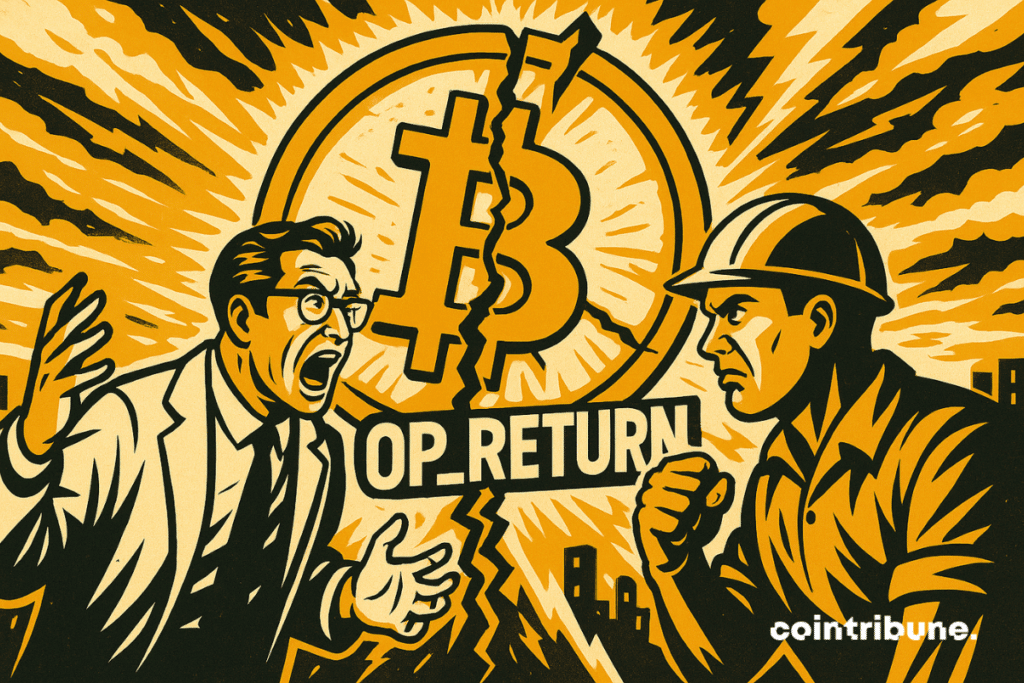Bitcoin’s Radical Evolution Sparks Purist Outrage—’This Isn’t the Crypto We Signed Up For’
Mainstream adoption forces Bitcoin to shed its cypherpunk roots—and the OGs are furious. Lightning Network upgrades slash transaction costs by 90%, while institutional custody solutions bypass the ’not your keys’ mantra. Even the SEC stopped yawning.
The new Bitcoin isn’t decentralized, private, or particularly rebellious. It’s fast, regulated, and Wall Street-friendly. Purists scream betrayal; VCs count their stacks. Meanwhile, that guy who bought a pizza for 10,000 BTC in 2010 just had a stroke reading this.
Funny how ’digital gold’ now behaves exactly like the fiat system it was meant to destroy—just with more blockchain buzzwords and hedge fund involvement. The revolution will be tokenized, monetized, and quarterly reported.

In Brief
- Bitcoin Core will remove the OP_RETURN limit to simplify and align network practices.
- This symbolic 80-byte limit was already bypassed by various technical workarounds.
- Critics fear a drift towards non-financial use and centralization of technical decisions.
A Rule That Has Become Counterproductive in Bitcoin
OP_RETURN allows. Introduced to avoid polluting scripts, it was a compromise: limited freedom but maintained security. Theaimed to.
But users quickly bypassed the rule. Some inserted their data via fake multisig scripts. Others used, creating much more pollution. Even some miners ignored this limit, making its application uneven.
Greg Sanders, a Bitcoin CORE developer, summarized the issue on GitHub:
Massive data inscriptions happen anyway, often more opaque and more harmful. The limit only redirects them towards worse practices for the network.
Therefore,.
BTCUSD chart by TradingViewVoices Rise Against the Change
But. For many users, the removal of this barrier was not discussed collectively. Marty Bent asserts on X:
It is clear that there is no consensus today on the OP_RETURN question.
On his side, Samson Mow calls for caution:
Many find this decision regrettable. They can remain on version 29.0 or use another client like BitcoinKnots.
Theis indeed this:Some denounce a gradual shift towards centralized governance, dominated by a few technical teams. The, though discussed on GitHub, lacked community consultation.
Thisshows how fragile protocol governance remains. Users are not all ready to follow imposed changes, even when they seem logical.
What It Really Changes
Behind this technical quarrel, there are:
- The removal of the limit cleans up UTXOs: fewer bogus scripts stored;
- Transactions will be more consistent between miners and nodes;
- This improves fee estimation and relay of compact blocks;
- Blocks remain limited to 4 million weight units, no explosive drift;
- Consensus rules do not change: only relay rules are affected.
This change is therefore. It is awith the network’s actual practice. Developers embrace a minimalist philosophy: the fee market must decide.
Protections against abuse will still exist. But they will be targeted and adapted to real threats. The project’s direction remains clear: avoid abuses while streamlining the protocol.
But the core of the debate goes beyond technique. It touches the very DNA of Bitcoin. Should symbolic rules still exist as usages evolve? Or should community control be strengthened? The removal of the OP_RETURN limit comes as the question of governance returns to the forefront. Charles Hoskinson, founder of Cardano, had already criticized the lack of clear structure in Bitcoin. Even today, this decision rekindles the debate: is the protocol governed collectively or directed behind the scenes?
Maximize your Cointribune experience with our "Read to Earn" program! For every article you read, earn points and access exclusive rewards. Sign up now and start earning benefits.

